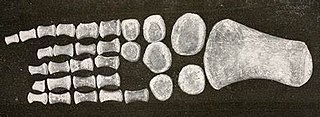Related Research Articles

Conodonts are an extinct group of jawless vertebrates, classified in the class Conodonta. They are primarily known from their hard, mineralised tooth-like structures called "conodont elements" that in life were present in the oral cavity and used to process food. Rare soft tissue remains suggest that they had elongate eel-like bodies with large eyes. Conodonts were a long-lasting group with over 300 million years of existence from the Cambrian to the beginning of the Jurassic. Conodont elements are highly distinctive to particular species and are widely used in biostratigraphy as indicative of particular periods of geological time.
Joseph John Sepkoski Jr. was a University of Chicago paleontologist. Sepkoski studied the fossil record and the diversity of life on Earth. Sepkoski and David Raup produced a new understanding of extinction events, by developing a statistical approach to the study of taxonomic diversification. He suggested that the extinction of dinosaurs 66 mya was part of a cycle of mass extinctions that may have occurred every 26 million years. But his most important contribution was the identification of the "Big 5" mass extinctions, events that have shaped the evolution of life on earth.

Scomber is a genus of ray-finned fish in the family Scombridae living in the open ocean found in Atlantic, Indian and Pacific Ocean. The genus Scomber and the genus Rastrelliger comprise the tribe Scombrini, known as the "true mackerels". These fishes have an elongated body, highly streamlined, muscular and agile. The eyes are large, the head is elongated, with a big mouth provided with teeth. They have two triangular dorsal fins, with some stabilizing fins along the caudal peduncle. The basic color is blue-green with a silvery white belly and a darker back, usually black mottled.

Ogmodirus is an extinct genus of plesiosaur found in the Cenomanian-Turonian Greenhorn Limestone of Kansas. The type species, O. martini, was named by Samuel Wendell Williston and Roy Lee Moodie in 1913.
Murchisoniceras is an extinct genus of cephalopod Nautiloid, that lived during the Silurian from 425 to 416 mya, in what would be Europe, existing for approximately 9 million years.
Spyroceras is a genus of pseudorthocerids from the Devonian of North America and Europe, defined by Alpheus Hyatt in 1884. Pseudorthocerids are a kind of orthocertaoid, a taxonomic group within the Nautiloidea. Specifically Spyroceras belongs to the pseudorthocerid family, Spyroceratidae.
Jovellania is a genus of extinct prehistoric nautiloids from the order Oncocerida known from the Lower Devonian of Europe. Nautiloids form a broad group of shelled cephalopods that were once diverse and numerous but are now represented by only a handful of species in two genera.
Wardoceras is an extinct nautiloid genus from the late Early Ordovician of Western Utah, assigned to the orthocerid family, Michelinoceratidae
Westonoceras is an extinct nautiloid genus from the Discosorida that lived during the Middle and Late Ordovician that has been found in North America, Greenland, and Northern Europe. It is the type genus for the Westonoceratidae
Endorioceras is an extinct genus of actively mobile carnivorous cephalopod of the family Baltoceratidae that lived in what would be North America during the Ordovician from 490–479 mya, existing for approximately 11 million years.
Bogoslovskya is an extinct orthoceroid cephalopod genus that lived in what is now Asia from the Devonian to the Permian.
Cryptocycloceras is an extinct genus of actively mobile carnivorous cephalopod that lived in what would be Europe during the Silurian from 422.9—418.7 mya, existing for approximately 4.2 million years.
Donacoceras is an extinct genus of actively mobile carnivorous cephalopod, essentially a Nautiloid that lived in what would be North America during the Ordovician from 460.5—443.7 mya, existing for approximately 16.8 million years.
Geisonocerina is an extinct genus from the carnivorous nautiloid cephalopod order Orthocerida that lived in what would be North America, Europe, and Asia during the Ordovician through Permian from 449 to 290 mya, existing for approximately 159 million years.
Hemicosmorthoceras is an extinct genus of actively mobile carnivorous cephalopod, essentially a Nautiloid, that lived in what would be present day Europe during the Silurian to Devonian from 422.9—412.3 mya, existing for approximately 10.6 million years.
Leurocycloceras is an extinct genus of actively mobile carnivorous cephalopod, essentially a Nautiloid, that lived in what would be North America, Europe, and Asia during the Silurian from 443.7—418.7 mya, existing for approximately 25 million years.
Orthocycloceras is an extinct genus of actively mobile carnivorous cephalopods, essentially a Nautiloid, that lived in what would be Europe during the Silurian to Devonian from 428.2 to 412.3 mya, existing for approximately 15.9 million years.
Parasphaerorthoceras is an extinct orthocerid genus, a nautiloid cephalopod, that lived in what would be Europe and north Africa during the Silurian from 422.9 to 418.1 mya, having existed for approximately 4.8 million years.
Vericeras is an extinct genus of nautiloid cephalopod that lived in what would be Europe during the Silurian from 421—418.7 mya, existing for approximately 2.3 million years.
Praeornis is an extinct genus of early avialan, possibly an enantiornithine, from the Late Jurassic Karabastau Formation of Kazakhstan. Only the type species is known, which is P. sharovi.
References
- ↑ PaleoBiology Database: Arionoceras, basic info
- 1 2
- ↑ J. J. Sepkoski. 2002. A compendium of fossil marine animal genera. Bulletins of American Paleontology 363:1-560